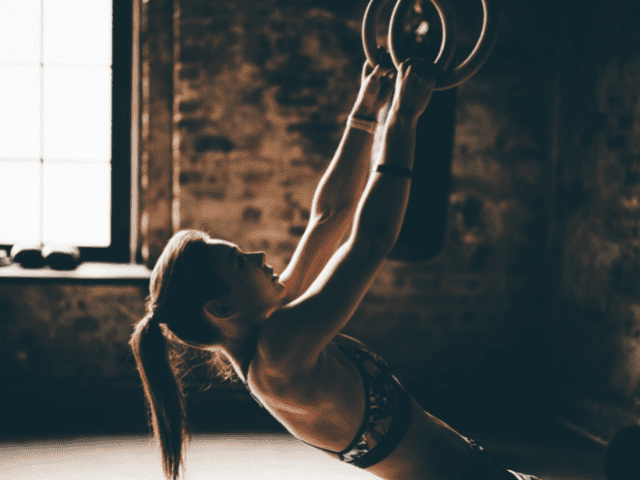Fat Grip Pull Ups (How To, Muscles Worked, Benefits)
One of the most basic but also probably one of the most important exercises a person can master is the pull-up. Fat Grip Pullups add the additional benefit of really challenging the forearms with the thicker bar.
In this guide, I will be going over how to do Fat Grip Pull-ups including coaching tips, muscles worked and a few alternatives.
This post includes affiliate links. If you buy something using these links I may earn a commission. Thanks.
How To Do Fat Grip Pull-Ups
Equipment Needed
- Fat Grip Pull Up Bar (Either as part of a rack or a wall-mounted bar)
OR
- A Regular Pull-Up Bar with a pair of Fat Gripz attached*
Step-by-Step Instruction
- Approach the fat grip pull-up bar and grab the bar with a pronated grip (palms facing away).
- Use a bench to get to the bar if it is too high.
- Squeeze the bar and engage the core muscles and do not cross your legs.
- Engage the upper back and pull up until your chin is over the bar.
- Pause for 1 second with your chin over the bar.
- Slowly lower yourself back to the starting position.
Coaching Points
If you don’t have a fat grip pull-up bar then I highly recommend getting a pair of Fat Gripz.
They can be attached to a pull-up bar, barbell or even dumbbells to increase the diameter of the grip, turning any piece of equipment into a fat grip. Almost any rowing exercise (Barbell Upright Rows, Dumbbell One Arm Rows, etc) can be turned into a forearm challenger. I’ve used them for years at every school I’ve worked at and they are worth every penny.
Take your time and master the pull-up. The benefits of doing sound pull-ups will pay dividends for your shoulder health and the potential to maximize your upper body strength.
I would highly recommend this movement to any lifter or athlete. It provides all the benefits of an upper-body pulling movement with little to no risk.
Common Mistakes
By far the biggest mistake I see in the pull-up is lifters not using a full range of motion. Hang all the way down and maintain great tension through the shoulders and abdomen (DO NOT JUST HANG IN THE BOTTOM). Pull all the way up and do not whip your head so that your chin barely makes it over the bar.
As with any exercise, do not sacrifice form for the completion or more weight.
Another mistake is lifters go too fast with their pull-ups. Pull-ups are commonly programmed for strength and hypertrophy. This means time under tension is key. Take them slow and perfect the movement to yield maximal results.
How Many Reps?
From a programming standpoint, Fat Grip Pull-ups are a primary strength movement. Recommended rep ranges are 3 to 4 sets of 6 to 12 reps.
From a practical standpoint, I encourage my athletes to do pull-ups on their own even with sets as little as 1 or 2 at a time. After a couple of sets are done on their own, the remaining reps can be completed with the assistance of either a resistance band or a partner.
On the other end of the spectrum, if an athlete can easily do sets of 10 to 12 reps, then variables like added weight or a slower tempo are introduced to make sets more challenging.
Muscles Worked
- Lats
- Upper back
- Forearms
- Biceps
- Abdominal and lower back muscles (Stabilizers in almost all movements)
Fat Grip Pull-Up Variations
Like regular pull-ups, Fat Grip Pull-ups have some great variations that can be utilized based on athletic readiness, training needs, and sport specificity.
Chin-Ups
Flip your grip and crush your chin-ups. The chin-up is where you have a supinated grip (palms facing in). This is generally considered an easier variation and can be used prior to the pull-up in a lifting progression and program.
The chin-up also engages more biceps.
Wide Grip Pull-Ups
Execute your pull-ups with a wider grip. This will highly engage the lats and upper back. This is a more advanced movement for lifters. I would not recommend this movement until the regular chin-up and pull-up movements are dialed in 8+ perfect reps can be completed.
Weighted Pull-Ups
Grab your weight belt and overload your pull-ups. Weighted pull-ups are one of the best variations a lifter can make to their training programs.
Once regular fat grip pull-ups are perfected, progressive overload must be challenged. I would highly recommend this lift for any lifter who is ready to challenge their upper body strength.
Fat Grip Pull-Up Alternatives
If a lifter is not ready for pull-ups, don’t worry. There are tons of movements that train the upper body for pulling.
Inverted Rows
Inverted Rows are another bodyweight back exercise that is not to be underestimated.
Set your barbell at bench press height. Take a pronated or supinated grip based on your needs. Extend your legs, engages the core, and pull yourself up the bar. Lock in the reps and slowly lower yourself back down. This is a fantastic movement for lifters to develop those posterior chain muscles.
Not only are they a great progression to get you on the path to being able to do pull-ups, but Inverted Rows would also be my recommended substitution if you have a rack but no pull-up bar.
Inverted Row From Rings

A simple progression for inverted rows is to use the ring implement. This allows for more movement at the shoulder. You can start with a pronated grip and as you pull, twist your hand. This is a great movement for rotational/overhead athletes like pitchers who need to build their external movers of the shoulder.
Also, if you don’t have a rack you can get creative with how to hang rings at home.
Lat Pulldown Machine

I do not often recommend machines but in this case, the lat pull-down machine is worth mentioning. If a lifter has a lower-body injury, the lat pull-down is a great option for continuing training while the lower half is being rehabilitated.
Lat Pulldowns are also a great option for novice and veteran lifters looking to add extra volume at the end of a session.
More Info and Links
Looking for some more great exercises to increase your upper body strength? Head over to our exercise library to find step-by-step exercises to help you get stronger. All for free.

